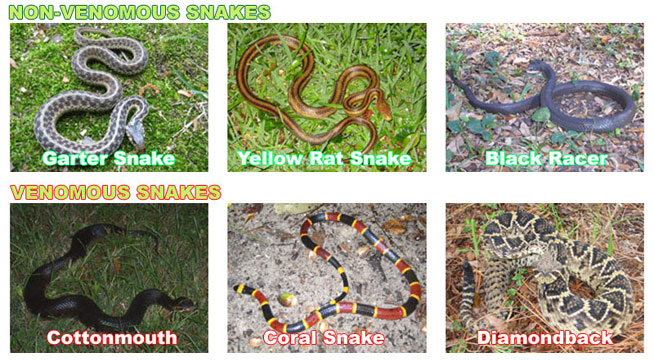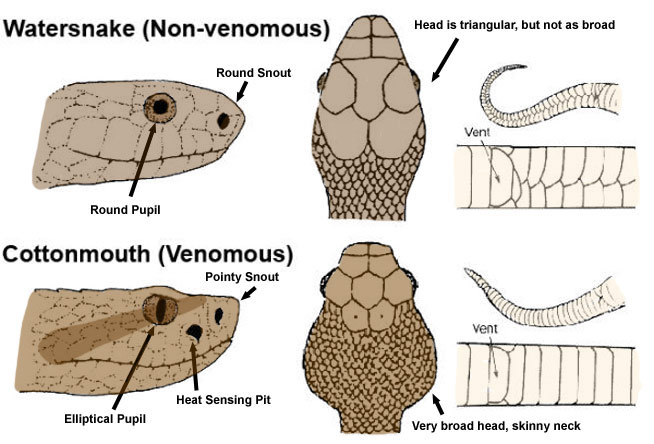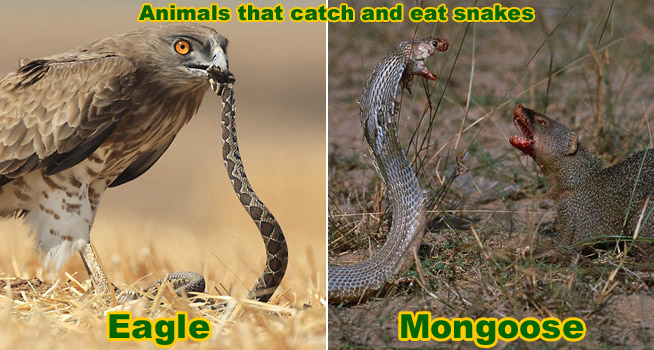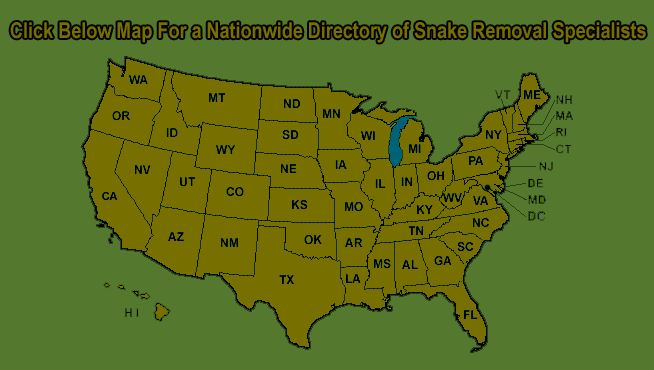I looked at Snake pages for a long time...
This was one of my Favorites! SRN
 |
http://www.snake-removal.com |
How to Identify a Snake Species
Read the below, but your best bet may be to simply type your location and a description of the snake into a search engine, and look at the image results.
Identifying snakes has little to do with the myths surrounding poisonous and non-poisonous characteristics and has more to do with body type classification. There are very few tricks that can be used when determining the venom factor, the only one of which is pupil shape. All snakes with slit-shaped pupils are poisonous. Not all poisonous snakes have slit-shaped pupils. This one certainty is often difficult to ascertain as it requires you to get extremely close to the snake to make your determination.
In reality, snake experts use a methodical system to categorize and identify a snake once it has been found. These basic guidelines are then cross-examined against a reference book. Many seasoned experts can tell a snake by visual alone, but for the rest of the population, the step-by-step identification process is handy.
The first characteristic accessed is body length. Snakes are categorized into three classes: small, medium, and large. Once length is determined, the width of the snake is also examined. If possible, actual dimensions should be gathered. A snake’s head shape can tell a lot about it, but does not necessarily mean anything in regards to venomous or non-venomous. Many pit vipers have triangular heads, but other snakes can resemble the same shape when they deliberately flatten their heads in aggression or anxiety. Knowing if the snake has a round, long, or oval head will help in identification but is not any proof of venom or lack thereof. Eye color, pupil shape, location on the face, and eye size should all be noted. These three identifiers: body length and width, head shape, and eye characteristics will narrow down the possibilities for species identification.

Color is usually very helpful in determining the type of snake you have located. Many snakes have distinctive patterns. Noting the patterns and the colors is very important. Sometimes the difference between a harmless snake and a deadly viper is one ring of coloration. Blotches usually refer to patterns with no symmetry. Theses markings are often rectangular with darker edges. If a diamond pattern is noted, color and color pattern should be noted as well. Are there speckles (flecks of color) or spots (large or small defined, solid color circles)? Ring patterns appear like bands around the width of the snake. Stripes are patterns lengthwise down the body. Note color contrasts. Some snakes are one color on the dorsal side and a different color on the belly. Distinctive markings on the head and neck may be present. Lastly, some snakes have no markings at all and are one, solid color.
Tail characteristics are another guide to identifying a snake. The tail is defined as the length of body stretching beyond the snake’s anus. Tails can end with a rattle. They can be pointed or rounded. Some have specific patterns. When the snake is turned over, is the scale near the anus single or divided?
Experts are able to use the number and arrangement of scales on a snake to further assist in the identification process.
Once all the information is gathered, a field guide will help you narrow down your list. The characteristics noted will pinpoint one or maybe a few species suspected. Some snakes are almost identical, and it is these snakes that need the assistance of habitat evaluation. If a snake cannot be identified by appearance alone, the habits of the species will come into play. Some snakes like rocky soil. Some snakes like sand. Some snakes eat only certain animals, or will only be found out at certain times of day. Not all snakes are found everywhere. Having a good, basic knowledge of the local area will help tremendously.
The important thing to remember is that most “quick” identification advice is based loosely on truth. You cannot always be certain of a snake’s venom potential just by the shape of its head, the color of its body, the habitat it lives in, or the color and shape of its eyes.
You may want to read my Shed Snake Skin Identification page if you've simply found the sheddings, and want to tell what type of snake left them behind.
Snake Enemies - Animals Catch Snakes
Yes, many animal species in the wild catch and kill snakes. Some of these species can even be trained in the art of snake extermination! Animal types that hunt and kill snakes include many species of raptors - eagles and hawks, honey badgers, and of course the notorious mongoose. King Snakes eat only other snakes. And believe it or not, common house cats and dogs catch and kill snakes too. Some species of dogs can be trained to catch and kill snakes.
What animals keep snakes away - First of all, no common house pet will keep snakes away without special training, and even then, you put the animal at great risk. Cats and dogs may do a decent amount of snake hunting, but they will not actively patrol your property just for snakes. You will have to take into account, too, the fact that any house pet exposed to snakes will also be prone to bite injuries. If you live in an area with venomous snakes, this can be disastrous. Pigs have been known to kill snakes, but again, these animals are not hunting the snakes, rather they are reacting instinctively and stomping the serpents when the opportunity presents itself. The mongoose is a pet that does have special attributes specifically for snake hunting and killing. These weasel-like animals eat snakes, and have special genetic attributes that make them immune to venom. The mongoose is very agile and has a thick coat, making it a perfect combatant for snake wars. The downside to the mongoose is that it’s importation to countries where it is not native is strictly regulated. The diet of the mongoose makes it a habitat destroyer when it is introduced into new environments. The urine of a mongoose can be used to repel snakes with some efficacy, but this is also not available to the public.
Why do snakes get scared of mongoose - It’s not necessarily that snakes become frightened when they smell a mongoose as much as they become wary. The mongoose is a fantastic little animal, resembling a stocky weasel and acting with prairie dog-like communication skills. It is naturally immune to snake venom and hunts serpents as a main food source. Mongoose urine has been used to repel snakes with moderate results, though the product is not available to the American public. Many countries in Europe and Asia keep mongoose as pets for the purpose of warding against snakes. Due to the little animal’s tendency to eat other creatures, its importation into other countries has been regulated. Some areas have experienced significant ecosystem damage from non-native mongoose population. Even a mongoose will not keep all snakes away all the time. Just like with an predator, the snake will acknowledge the mongoose scent, but unless it sees on, it may just proceed forward with caution.
What dog keeps snakes away - There are no dogs that are born with an insatiable desire to hunt and kill snakes, largely because snakes are not a part of the canine diet. There are certain breeds with stronger hunting instincts than other, like the Rat Terrier or the Airedale. These dogs will be more inclined to chase and kill a small, moving animal, but they will not patrol your property specifically looking for snakes. Keep in mind that any dog will be subject to the bite wounds that come from tangling with snakes around the yard. Animals are just as prone to infection as humans, and a dog with multiple puncture wounds will need frequent veterinary visits. The cost of this constant care will quickly outweigh any benefit the canine has as a rattlesnake hunter. Some dogs will even avoid snakes after being bitten. If you bought the dog strictly for snake hunting, that’s a touch pill to swallow. Now, you will have a dog and you will have snakes still in the yard. The only pet that is really effective against snakes is the mongoose; however, their importation into North America has been prohibited due to the little critter’s habit of taking over ecosystems.
Snake fear pig - Snakes do not naturally fear pigs, though pigs and many hooved animals fear snakes. This is what leads to the volatile responses from animals like the pig when a snake is seen in the pen. Pigs don’t like snakes because both animals are close to the ground. The last thing the pig wants is the snake to injure one of its young. For this reason, pigs are instilled with a deep desire to run down any snakes and stomp them to death. It has nothing to do with snakes and pigs having a vendetta. Snakes are simply known predators of baby animals, and the pig is aware of this. The snake will not be fearful of the pig as long as the larger creature keeps its distance. This is how most animals are, and this is why many predator decoys and urine repellents fail to do any good. Animals, even natural enemies, will tolerate one anothers presence if no immediate threat is felt. A snake can pass through a pig’s territory, but if the serpent gets too close to something important, the pig will let it know. Keeping pigs on your property will not keep snakes away. Pigs are not snake hunters, and they will not spend much time or energy looking for a fight.
Who is the enemy of snakes? Although a ton of animals prey on snakes, from owls, coyotes, bobcats, foxes, raccoons, weasels, snapping turtles, alligators, even crows, it is not easy to come by trainable pet animals that eat snakes, if you're looking for a type of animal that kills rattlesnakes or any venomous snakes, to help you with a snake removal project. It's not a common or practical thing done, and I know of no special trainer, service, or company that offers animals to control snakes, or training for dogs or cats to catch and remove snakes. I did once see a Secretay Bird in a zoo that was great at catching snakes and well trained, but I doubt you're going to go to your local pet store and pick up a Secretary Bird, Snake Eagle (Circaetus), or even serpent hedgehog. Your best bet for snake control is either of the below options.
Option 1 - HIRE A PROFESSIONAL
Click your state on this map in order to hire a professional in your area. This website lists snake removal experts in 472 different US cities and towns.
Option 2 - BUY A SNAKE TRAP
I have reviewed and field tested several snake trap designs, and the one featured on this website is the most durable and effective. It is the highest quality snake trap available on the market. You can purchase it securely right here from this website:Click Here To Buy Professional Grade Snake Trap.

For more information, go to my Snake Removal - How to Get Rid of Snakes home page.
Coral Snake (courtesy Flickr)
No comments:
Post a Comment
Do To the enormous amounts of spam I will no longer take the time to moderate Anyone posting under anonymous... Sorry for the inconvenience but my email is blasted everyday with 40 to 50 anonymous posts that are junk mail. I just don't have the time to read each one before deleting.